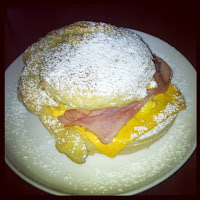He arrived for our date with cookbooks in tow. On his last trip to Puerto Rico, he purchased a cookbook for me called Puerto Rico True Flavors by Wilo Benet. Over drinks at the bar, we leafed through every page of this cookbook discussing each dish…what made it special, its origins, when his family served it, how his mother made it. For instance, he explained how his grandmother and all of the tias would get together during the holidays and form an assembly line to make pasteles, a dish similar to tamales but made with green bananas or tubers, instead of cornmeal, and steamed in banana leaves, instead of corn husks. He described ingredients that are uncommon in the US, but specific to Puerto Rican cuisine, such as breadfruit, chayote, and aji dulce. (He also brought me an aji dulce plant that is now growing in my yard. He said that it will produce prolifically and that the peppers can be preserved in vinegar for months. I can’t wait for our first fruit.) Carlos loaned me his copy of an out of print cookbook by Dora Romano, Rice and Beans and Tasty Things. He shared with me that his dad sent it to him many years ago, and although this book may not have glossy photos, the text presents a full interpretation of Puerto Rican cuisine. To say the least, he provided me with more information, recipes, and ideas than I could ever tackle in one week, but I did my best to celebrate the highlights.
Mallorcas
 |
| mallorcas fresh from the oven |
 |
| mallorca stuffed with egg, ham, and cheese |
Fritters
Fritters are such an essential part of Puerto Rican cuisine that Wilo Benet’s cookbook includes an entire chapter dedicated to them. One of my favorite places to visit in Puerto Rico is an area near Luquillo Beach referred to as “the huts” which is a long row of over fifty kiosks, each known by its number, lined up down the highway for what seems like over a mile. For me, a trip to the huts means starting on one end and working my way down the line ordering a different fritter and an ice cold 8 oz can of beer at each kiosk until I can’t eat or drink anymore. Such fun!
I chose to make two fritters for this week’s project: almojabanas and alcapurrios de jueyes.
 |
| alcapurrios de jueyes |
 |
| almojabanas |
Roasted Pork, Stewed Pigeon Peas with Plantain Dumplings, Rice, and Tembleque
One of these days, I am going to make it over to the lechoneras of the infamous “pork highway” for a day of gluttony. Until I do, I will dream of the Roast Pork we made at home for our weekend of Puerto Rican fare, because it was awesome!
From time to time during the project, I specifically select dishes that the hubs will enjoy, because he is always such a great sport about my transitioning weekly menus. For sure, any smoked and/or roasted pork dish is always at the top of his favorites list, and I knew he would be excited to try out a new variation. In Steven Raichlen’s Planet BBQ, he only features one Puerto Rican recipe, Lechon Asado, and really, that’s all he needed to include…it’s amazing! The technique he offers for treating the skin produces the most incredible chicharron with a smoky flavor and crispy skin atop a thin layer of unctuous fat. Here’s to make it:
-
Start with a bone-in, skin-on pork shoulder. - Slice the skin off the shoulder in one large piece and set aside.
- Poke holes in the roast and fill them with garlic cloves and fresh sprigs of oregano.
- Rub the shoulder with an adobo spice blend (salt, dried oregano, dried sage, garlic powder, onion powder, black pepper).
- Drizzle the pork with two tbsp of olive oil and rub it into the spices and the shoulder.
- Tie the skin back onto the pork with butcher’s string.
- Roast the pork (skin facing up) using indirect heat on a charcoal grill. We added applewood chunks to the coals every hour. Every thirty minutes, baste the pork with annatto oil, and roast until it reaches an internal temperature of 190 degrees F. (For our nine pound shoulder, the roasting time was about four hours.)
 |
| pork shoulder & chicharrons |
 |
| gandules con bolitas de platano |
 |
| tembleque |
Mofongo
 |
| mofongo and stewed pigeon peas |
To say the least, we ate well during Project Puerto Rico, even better than I expected. In addition to fabulous food, I enjoyed spending time with Carlos and listening to his stories about growing up in Puerto Rico. All in all, a week that I will cherish and remember fondly.


No comments:
Post a Comment